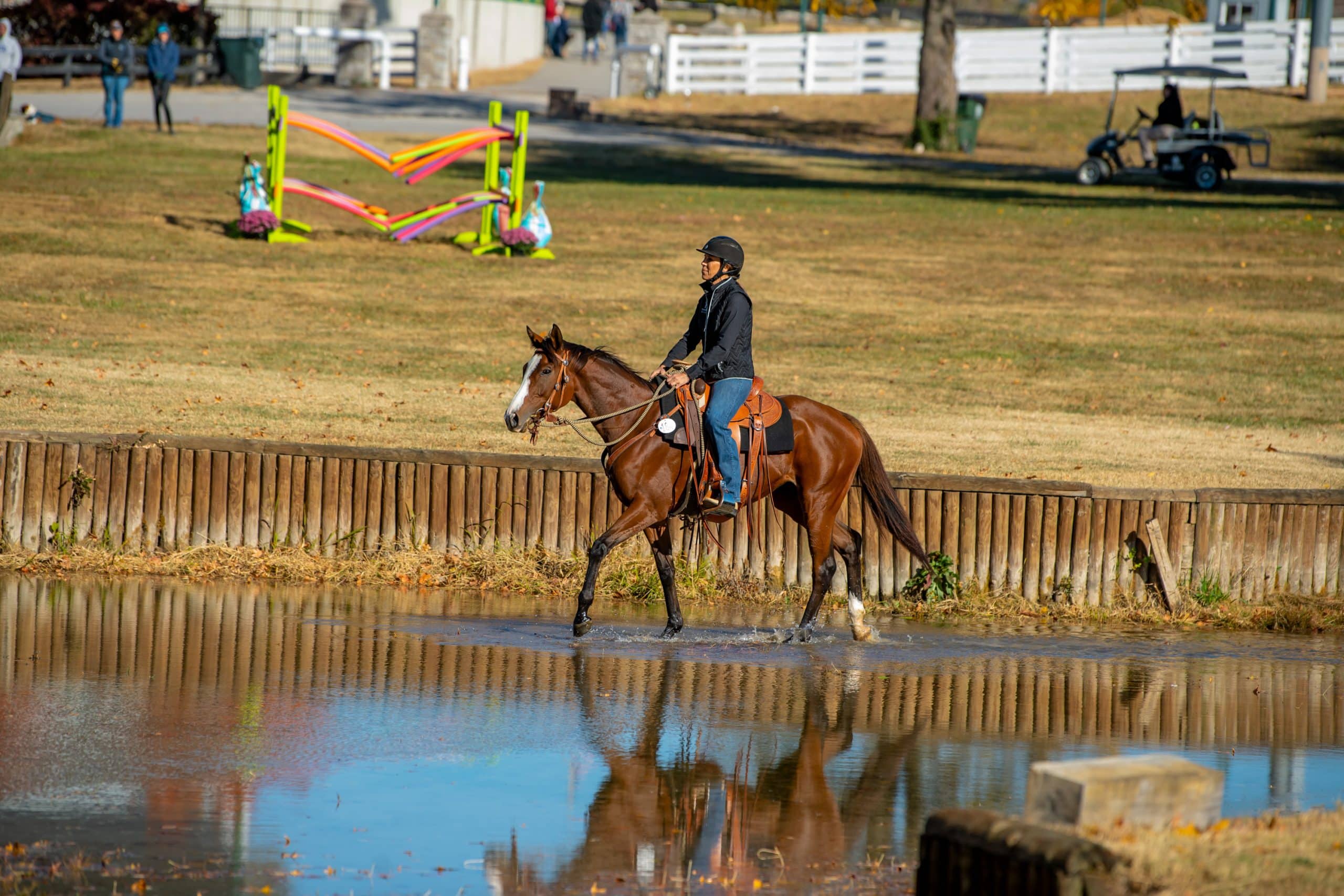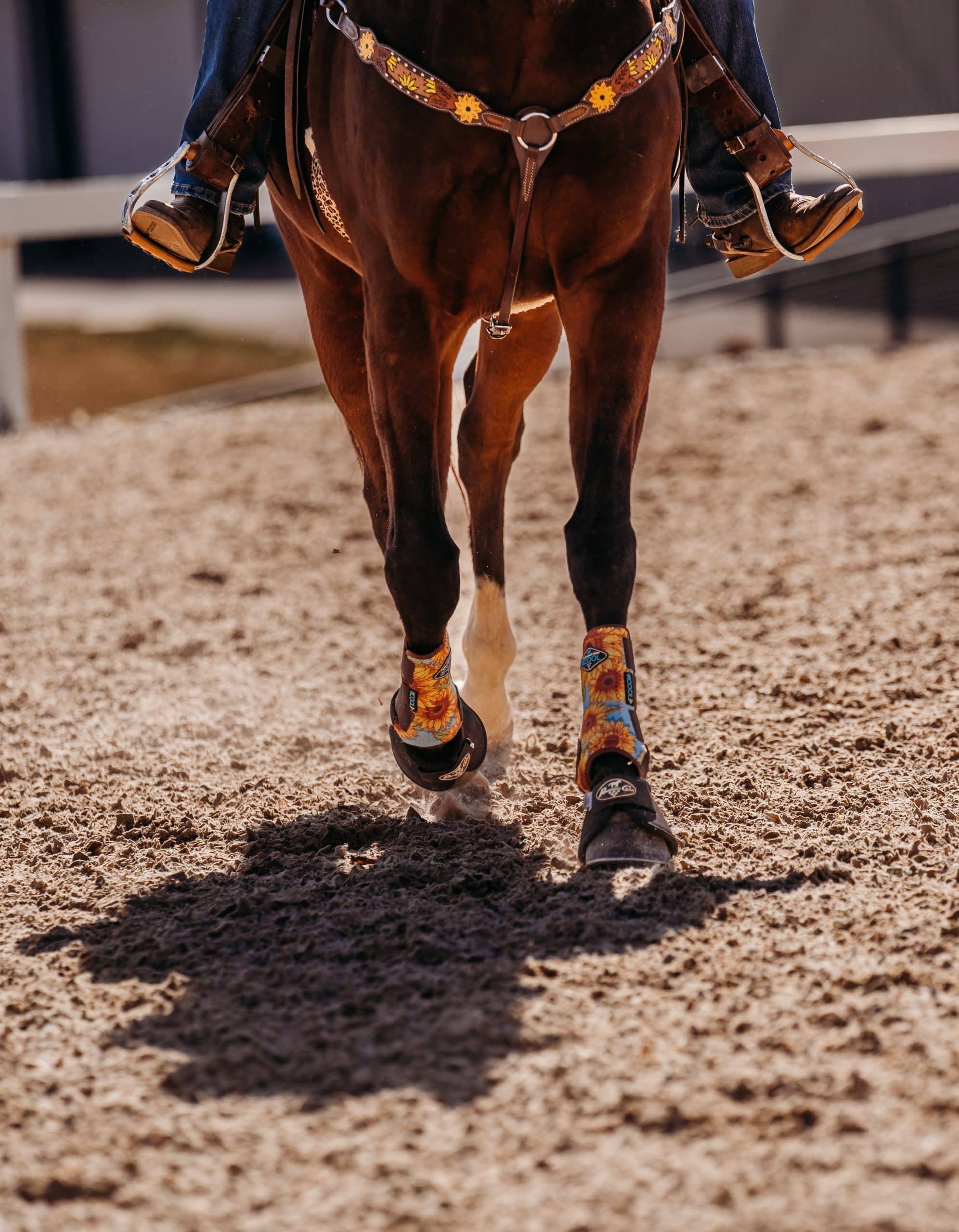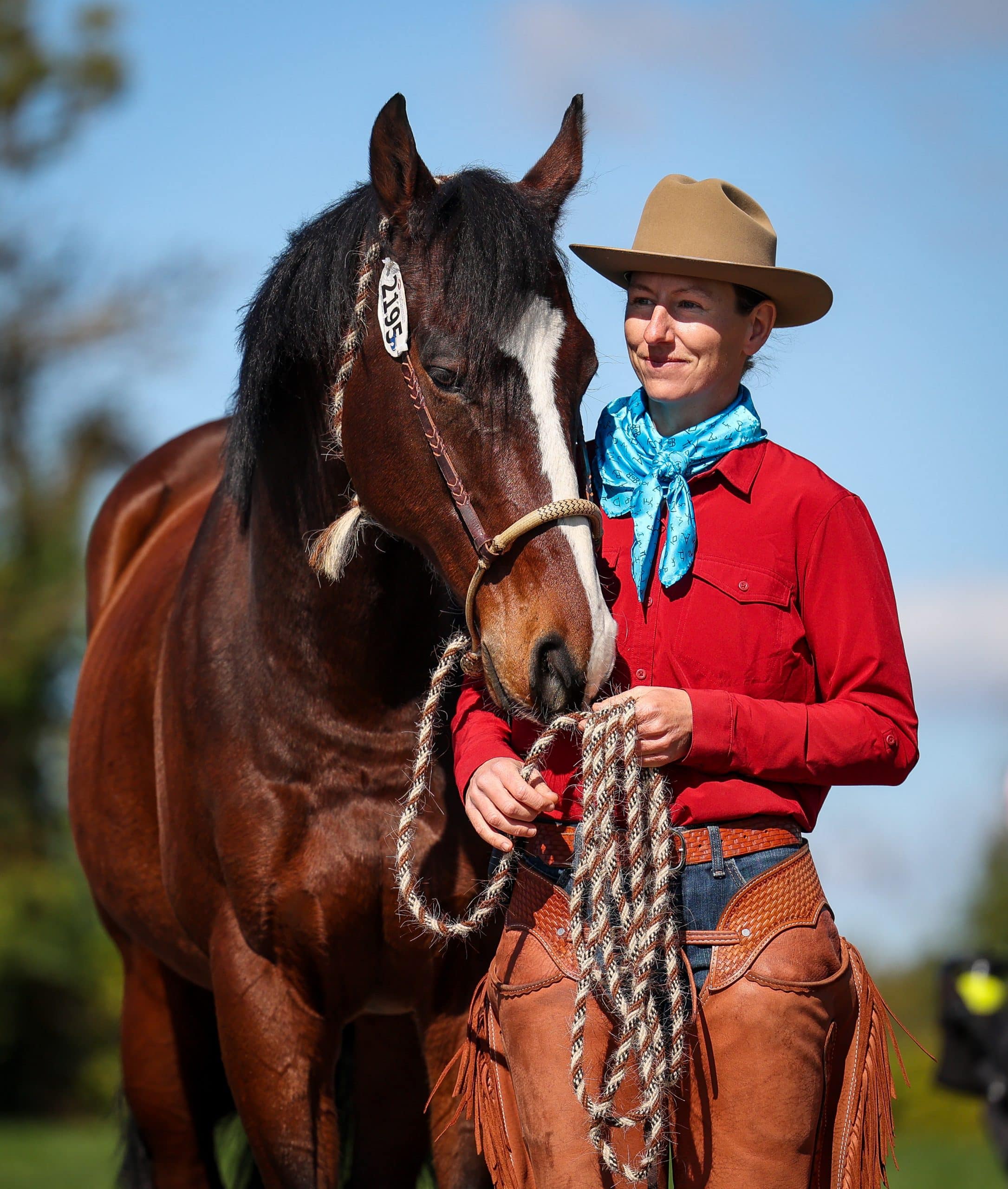
Diggin for Dough and Toni Harmon tackle the trail course at the 2022 Makeover. | Courtesy Pyrois Media
The stereotypical Western movie shows cowboys chasing cattle and climbing treacherous terrain aboard their trusty stock horses — American Quarter Horses or Paints, perhaps. Horses sporting heavy work saddles and shanked bits look more rough and ready for anything than slick and fast.
At least, that’s what we’re used to seeing on the big and small screens. Lately, though, there’s been an insurgence of a new royal pedigree among the working type, thanks to the increase in popularity of the Thoroughbred. The breed has shown true versatility and excellence in Western events not only at the Retired Racehorse Project’s Thoroughbred Makeover but also on ranches out West and in rodeo arenas across the country.
Taking a retired racehorse from the fast-paced world of track life and slowing him down, however, can be a tricky transition.
Choosing a Western Prospect
When it comes to choosing an OTTB prospect for Western sport, the most obvious physical trait is the horse’s height. A Western horse is typically shorter, between 14 and 15.2 hands.
During individual events for the Western discipline, horses must be agile, able to perform quick stops and fast turns on their hindquarters and possess the ability to take off and stop on a dime. A smaller stature allows for more ease in these movements than the longer, lankier build of some 16- to 17-hand Thoroughbreds.
“We don’t need to go over big jumps, obviously,” says Jody Busch, Makeover veteran and owner of Jody Busch Horsemanship, in Saskatchewan, Canada. “If you’re going to be trail riding or working cattle, you’ll be doing a lot of opening and closing of gates, so you’re getting off and on the horse a lot. You want something that’s not going to hurt your knees or break your back.”
Stockier horses typically fit the Western lifestyle better than tall, rangy ones. Horses with a shorter back and croup have the ability to stop and make sharp turns easier. Busch likes to look at horses that have more of a fast-twitch response, much like sprinters, because they can move and react quickly.
“It might be hard to look at a horse fresh off the track because they’ll be in running shape, so you’ll have to really look at their bone structure,” says Robin Stang, a Pennsylvania-based American Quarter Horse Association Professional Horseman and Thoroughbred Makeover judge. “But you can tell a lot by their hind end if they’ll make a good stock horse.”
Busch strongly suggests considering the horse’s feet. “I think feet for Western riding is a really important factor,” she says.
This is because most Western horses are ridden outside of a neatly groomed arena. Trail riding, working on the ranch and traversing steep, varied terrain all require a strong hoof as the horse’s foundation. While most OTTB prospects are still shod in racing-type shoes, look at the condition of the feet and, if possible, speak with the farrier that worked on the horse at the track.
It’s often difficult to discern initially, but an OTTB’s mind and personality are extremely important components for a Western prospect.
“A lot of times people will purchase a Thoroughbred off the internet, so they won’t get a chance to really get to know the horse’s personality until he ships home,” Stang says. “No one wants a horse that’s sour or has a bad attitude, but it’ll take time to see how the horse mellows out away from the track.”
Keep in mind that just because a horse acts one way in the shedrow, amid the hustle and bustle of track life, doesn’t mean that’s his true personality. Busch has had experience with horses’ demeanors changing after transitioning to new careers.
“I’ve spent a fair amount of time at the racetrack, and horses can act completely different at a track than they do when you bring them home,” she says. “One horse we had for training was the easiest horse to deal with on the track, and everyone thought she’d be the easiest to restart. However, when you changed her routine, she became anxious, and leaving the routine of the track was very difficult for her. Another horse I purchased was hot, sensitive and anxious, weaved in his stall and cribbed, but once we put him in a pasture with a round bale and a herd of geldings, he calmed down right away.”
Cinching Up

Consider that your OTTB might not be accustomed to the feel of a leather breast collar across his chest. | Courtesy Captivation Photography
Trainers employ a variety of strategies after bringing home a retired racehorse. One route is to turn the horse out and let him have some time off, away from the track and the stressors of training. The other route is to begin working with the horse immediately, allowing him to adjust while learning.
It all depends on your horse’s temperament, physical abilities at the time (Is he injured and in need of time to recover?) and your goals.
Busch is one who likes to bring the horse home and get to work immediately. “I really do like to ride a horse right away — once or twice if I can — just to get a sense of what the horse is like,” she says.
Then it’s back to focusing on the foundation. Stang points out that how a horse transitions to working off the track can depend on his very first rides, before he ever set foot on the track. “The hard part about retraining a retired racehorse is knowing who started him,” he says. “If the horse was started right, with experiences outside of the stall and away from the track, then they should have a good foundation on them already. If the horse was started right, he’ll be a good horse that’s easy to retrain.”
While the Western saddle is noticeably heavier than a flat racing saddle, Busch and Stang have never seen OTTBs have issues with the weight.
“I’ve never had a horse get real upset about a Western saddle, but most Thoroughbreds aren’t used to a back cinch or a breast collar,” Busch says.
Therefore, she takes her time getting the horse used to the pressure of the back cinch around the back of his barrel by using a rope or lariat in that area for a few weeks before tightening up a real back cinch. With the breast collar, Busch likes to do groundwork with the horse tacked up, so he can get accustomed to the feel of the leather moving across the chest and pulling in areas he hasn’t experienced before.
“You don’t want to be halfway up a steep hill and have the breast collar engaged across the chest to find out if the horse has any issues with that feeling or not,” she says.
Introducing other pieces of equipment, such as roweled spurs, swinging ropes and saddle bags, takes time. For the safety of the horse and the rider, Stang and Busch recommend doing a lot of groundwork that incorporates those types of equipment.
Slowing the Pace

Jody Busch retrained Papa Al for the 2021 Makeover, winning Freestyle and finishing eighth in Ranch Work. | Courtesy Canterclix
Thoroughbreds are conditioned to move fast — they typically walk with a long stride and move with purpose in each gait. Slowing that pace down for a Western discipline like trail or ranch work doesn’t have to be a battle of wills, however.
“I think it’s really important, when we ride these horses off the track, that we meet them in the middle a little bit,” says Busch. “They’re used to going. So, when I go to trot the first number of rides, I believe in getting going right away. A big horse wants to trot and possibly move into the canter, because that’s what they know. It mostly just relaxes them. They’re so happy to be moving and get moving. So, I would do very little walking for the first many, many rides, just to make sure that I’m meeting them in the middle so as they start to understand about slowing, then I worry about the walk.”
Busch rides the first rides in a half-seat and posts the trot because that’s what the horse is accustomed to. Thoroughbreds are not used to a driving seat, so it’s all about setting it up so you’re not fighting with them, she says.
Trainers shouldn’t worry about the horse’s headset or speed for the first rides, Busch adds. She likes to work with the horse at his pace, letting him take the time to understand he doesn’t have to rush and can move in a slower, calmer rhythm. She does much of her training in an open field and working in circles — things the Thoroughbred has not experienced before. She lets the horse choose the gait and the pace (if it’s safe), and they work together in a circle around a cone until the horse slows down on his own. She rides in a hackamore or knotted rope halter before changing to the bit of her choice.
Bring a Buddy
Take a chapter from the book at the track, and remember your OTTB is used to being worked alongside a pony horse. Pony horses are known for being a calming presence for the racehorse — a tool that can help with your retraining. If you’re comfortable with it and have a steady, quiet saddle horse, Busch highly recommends ponying as a way to get your Thoroughbred used to the Western lifestyle.
“Take advantage of the fact that most OTTBs have been ponied,” she says. “That is a place to meet them in the middle, too, and you might find a lot of success working them off horseback, ponying them, working them in the round pen with your saddle horse. If you’re going to expose your horse to cattle or trail riding or go on a big mountain ride that you’re not sure if they’re ready, then you need a horse to pony off. Take them along with the pony so they can experience it in that way, if they’re not ready to experience it with you in the saddle.”
Take-Home Message
You can never expose your horse to too much while you’re retraining, says Busch. “Get him out as soon as possible (after the track) and a lot,” she says. “Don’t feel like you’re stuck in the arena. Make sure you go on a trail ride. It’s so good for them, it helps them decompress from the track. Just don’t rush the horse. Remember to meet him halfway, and you’ll succeed.”

